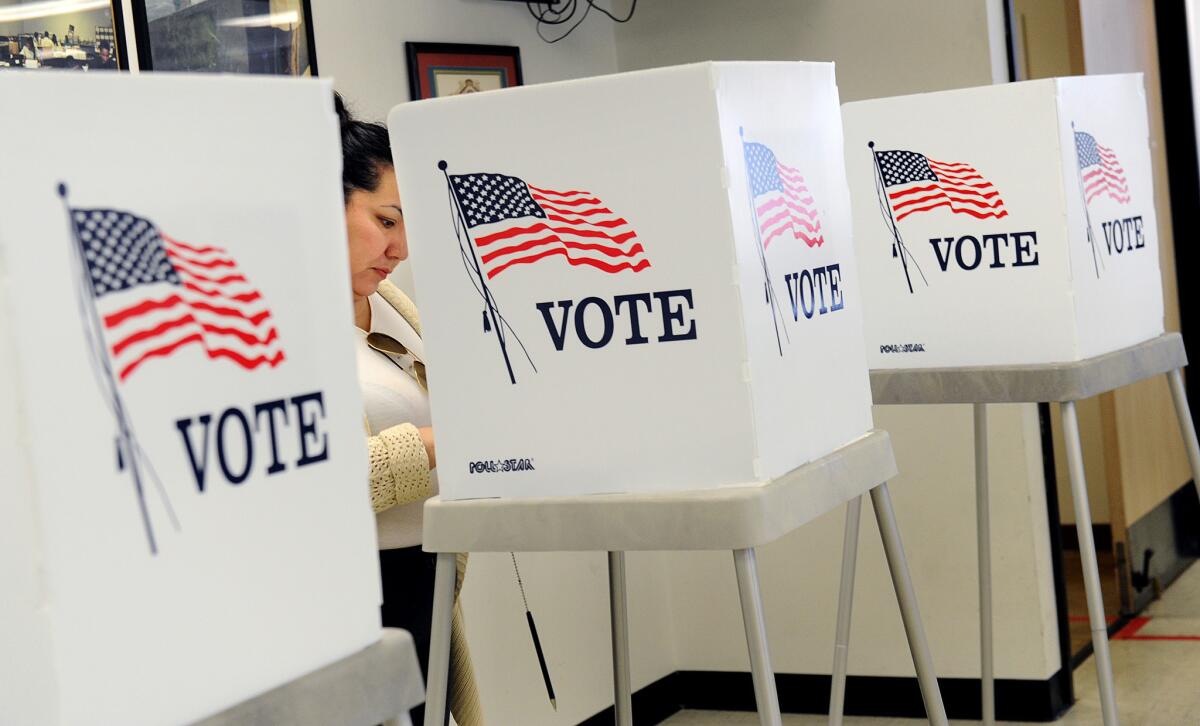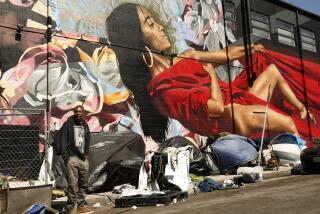First & Spring: A push to increase L.A. voter turnout

L.A.’s political leaders hit the jackpot six years ago, persuading voters to approve three tax increases on the same election ballot — one for schools, another for colleges and a third to expand the county’s transportation network.
The outpouring of generosity came in an election year with enormous turnout. Nearly 83% of Los Angeles voters cast ballots in November 2008, many lured by the prospect of choosing Barack Obama as the nation’s first African American president.
Now, Los Angeles City Council President Herb Wesson is looking to persuade voters to hold all city and school board elections in even-numbered years, when higher-profile state and federal contests are on the ballot. The move is part of a push to increase voter participation, particularly among young adults and people of color. But some believe the change will also produce, intentionally or not, another result: making it easier for City Hall to win passage of new tax increases.
If the change in election dates is approved by voters March 3, “you’ll see more tax measures ... supported by well-funded special interests,” said Mike Eveloff, president of the nonprofit advocacy group Fix the City. The pool of voters will expand so much, he said, “that only well-funded special interests will be able to reach that larger electorate.”
Eveloff hasn’t decided whether to support Propositions 1 and 2, which would move city and school board elections to even-numbered years starting in 2020. But his warnings of an increase in tax measures raises a larger question: If L.A., in its bid to reinvigorate democracy at the local level, succeeds in getting more people to cast ballots, how might that affect City Hall decision-making?
For decades, Los Angeles has conducted its city and school board contests in odd-numbered years, three to four months after big November state and federal elections. The timing has been confusing for many voters, contributing to lower turnout. The voters who do show up tend to be whiter, older and more skeptical about City Hall leadership and ballot proposals, political experts say.
In 2009, when Mayor Antonio Villaraigosa was running for reelection, L.A. voters narrowly defeated a solar energy proposal backed by the Department of Water and Power, a surprising step for an environmentally friendly city. In the 2011 city election, voters imposed a tax on medical marijuana but rejected one on oil production.
And during last year’s low-turnout mayoral election, voters handily vanquished a sales tax hike — one championed by Wesson as a way to balance the city’s budget.
The council president initially received polling data showing his proposed sales tax hike had nearly 2-to-1 support among likely voters. But on election day, with only 20.8% of voters casting ballots, the measure failed to win even a simple majority. Harvey Englander, a lobbyist and political consultant who worked on the campaign, said turnout would have needed to reach at least 30% for the tax to pass. “When you have a low voter turnout, it’s generally a more conservative turnout,” he added.
Wesson would not draw a link between last year’s anemic turnout and the defeat of the tax increase. A much bigger problem for the sales tax, he said, was the opposition from every major mayoral candidate. Wesson also bristled at the idea that changing election dates is about anything other than getting more people to the polls.
While talking up the two March ballot measures, Wesson has hammered on the importance of voter turnout to a democracy, citing the historic civil rights struggles of African Americans and more recent battles against voter ID laws in other parts of the country. “For me, increasing the turnout is personal, OK?” he said.
Still, one high-profile civic leader says higher voter turnout is indeed likely to change City Hall.
Kathay Feng, executive director of the watchdog group California Common Cause, said younger and minority voters — those who show up in greater numbers for state and federal elections — are more likely to support higher taxes, wage increases, greater investment in education and efforts to protect renters. “When we change the electorate to be more reflective of the public at large, there will be different decisions,” she said.
Feng served on two citizen commissions that recommended the change in election dates for city contests. She says she supports the switch because of the need to address the city’s “abysmal” turnout, not out of a desire for policy changes at City Hall.
When Wesson brought the March ballot proposals before the council, he invited both Feng and attorney Darry Sragow to talk about the potential benefits. Sragow, a former political consultant, helped the Los Angeles Unified School District win voter approval of four school construction bond measures — essentially property tax hikes — between 1997 and 2008. During his testimony, he told lawmakers that those types of measures typically perform better in state and federal election years.
------------
FOR THE RECORD
Dec. 1, 7:42 a.m.: An earlier version of this article referred to attorney Darryl Sragow. His first name is Darry.
------------
Political science professor Fernando Guerra, director of the Center for the Study of Los Angeles at Loyola Marymount University, agreed that a switch to even-numbered years would bring out more voters who are Latino, Asian and left-leaning in their political views. But Guerra, who headed the city commission that recommended a change in election dates, doesn’t buy predictions of additional taxes or greater influence by special interests.
Once city, state and national candidates are on the same ballot, the power of special interests in local elections — particularly unions and real estate developers — will be weakened, said Guerra, who is also a registered lobbyist at City Hall.
“There will be so many more candidates on the ballot, they’ll have to dilute their resources,” he said.
More to Read
Start your day right
Sign up for Essential California for news, features and recommendations from the L.A. Times and beyond in your inbox six days a week.
You may occasionally receive promotional content from the Los Angeles Times.







